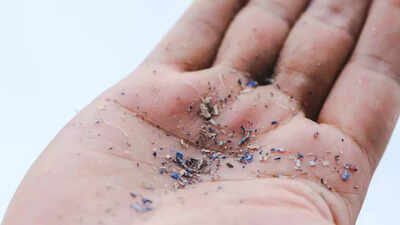- News
- lifestyle
- health-fitness
- diet
- Eating food invites microplastics inside the body: These 3 simple diet changes will reduce that
Trending
Eating food invites microplastics inside the body: These 3 simple diet changes will reduce that
Microplastics are ubiquitous in our food chain, originating from plastic packaging, polluted water, and more. Microplastics have made their way into our food, water, and even our bodies, but you have the power to reduce their impact. Small changes in your daily diet can lead to big improvements in your health—so why not start today?
It is a fact that every time one eats, they might also be consuming tiny plastic particles known as microplastics. These invisible invaders come from plastic packaging, contaminated water, and even the air. Studies have found microplastics in human blood, lungs, and even the placenta, raising serious health concerns. Microplastics and nanoplastics (MNP) exposure can cause inflammation, oxidative stress, and even affect brain function. But here’s some good news: we can make one simple diet change to reduce our microplastic intake.
What are microplastics and why are they harmful?
Microplastics are tiny plastic particles, which are mostly smaller than 5 millimeters, that enter our food chain through plastic packaging, polluted water, and even the utensils we use. indicate that 10-40 million tons of microplastics are released into nature every year. These particles are then transported through wind and water, contaminating our food, water, and air.

What is the simple diet change?
The best way to reduce microplastic intake? Eat fresh, whole foods instead of packaged and processed ones. Processed foods often come in plastic packaging, which sheds microplastics into the food, especially when exposed to heat.
that regularly consuming canned food significantly increases bisphenol A (BPA) levels, a harmful plastic compound, in the body. Replacing bottled water with tap water alone can reduce microplastic exposure from 90,000 to 4,000 particles per year. Going for whole foods like fresh vegetables, grains, and proteins instead of industrially processed meals can lower your plastic exposure dramatically.

<p><br><a target="_blank" href="http://jeetbetwin.com/life-style/health-fitness/web-stories/10-yoga-asanas-to-lower-uric-acid-naturally/photostory/118234962.cms"><strong>10 yoga asanas to lower uric acid naturally</strong></a><br><br></p>
Avoid plastic-wrapped and packaged foods
Most packaged foods, from snacks to ready-made meals, contain traces of microplastics due to plastic wrapping and storage. A study even found that tea bags could release billions of tiny plastic particles into your beverage, far surpassing previous contamination estimates.
To minimise exposure:
- Buy fresh produce from local markets instead of plastic-wrapped fruits and vegetables.
- Store food in glass, stainless steel, or bamboo containers instead of plastic.
- Avoid canned foods, as they can increase BPA exposure by over 1,000% in just five days.

Switch to glass, steel, or bamboo for storage and cooking
Plastic containers, especially when heated, release microplastics into food. found that heating food in plastic containers, particularly in the microwave, may release up to 2.11 billion MNPs per square centimeter in just three minutes.
To reduce this risk:
- Store leftovers in glass jars instead of plastic containers.
- Avoid heating food in plastic—use ceramic, glass, or stainless steel instead.
- Use wooden or bamboo utensils while cooking instead of plastic spatulas.
Drink filtered water instead of bottled water
Bottled water has been found to contain twice as many microplastics as tap water. A simple switch to filtered tap water can drastically cut down your microplastic intake.
Inhalation is a significant route of MNP exposure—adult males inhale over 62,000 particles each year. Using a high-efficiency particulate air (HEPA) filter may help remove up to 99.97% of airborne microplastics, reducing respiratory exposure.

About the Author
TOI Lifestyle DeskEnd of Article
FOLLOW US ON SOCIAL MEDIA
Visual Stories
Tired of too many ads?








